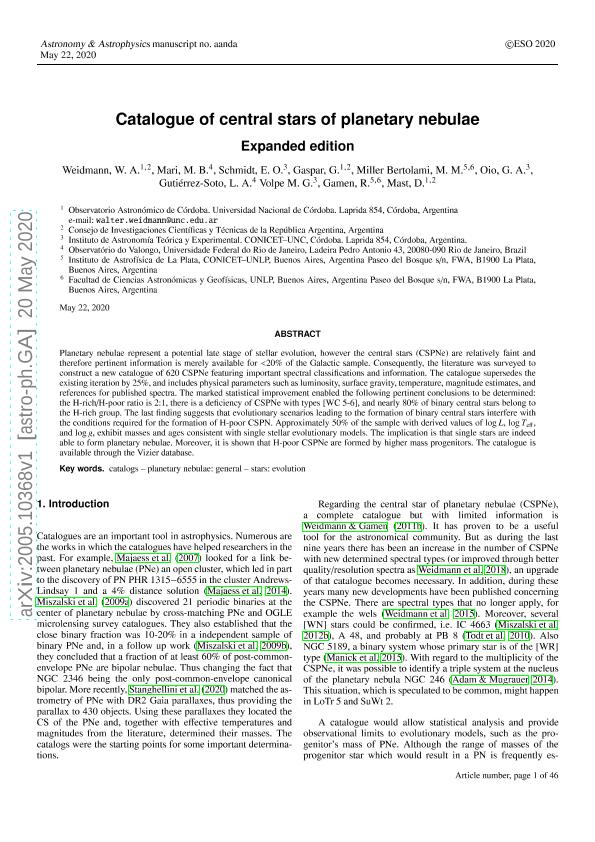Mostrar el registro sencillo del ítem
dc.contributor.author
Weidmann, Walter Alfredo

dc.contributor.author
Mari, M. B.
dc.contributor.author
Schmidt, Eduardo Osvaldo

dc.contributor.author
Gaspar, Gaia

dc.contributor.author
Miller Bertolami, Marcelo Miguel

dc.contributor.author
Oio, Gabriel Andrés

dc.contributor.author
Gutiérrez Soto, L. A.
dc.contributor.author
Volpe, Maria Gabriela

dc.contributor.author
Gamen, Roberto Claudio

dc.contributor.author
Mast, Damian

dc.date.available
2021-08-17T16:56:15Z
dc.date.issued
2020-08
dc.identifier.citation
Weidmann, Walter Alfredo; Mari, M. B.; Schmidt, Eduardo Osvaldo; Gaspar, Gaia; Miller Bertolami, Marcelo Miguel; et al.; Catalogue of the central stars of planetary nebulae: Expanded edition; EDP Sciences; Astronomy and Astrophysics; 640; 8-2020; 1-54
dc.identifier.issn
0004-6361
dc.identifier.uri
http://hdl.handle.net/11336/138349
dc.description.abstract
Planetary nebulae represent a potential late stage of stellar evolution, however, their central stars (CSPNe) are relatively faint and, therefore, pertinent information is available for merely < 20 of the Galactic sample. Consequently, the literature was surveyed to construct a new catalogue of 620 CSPNe featuring important spectral classifications and information. The catalogue supersedes the existing iteration by 25 and includes physical parameters such as luminosity, surface gravity, temperature, magnitude estimates, and references for published spectra. The marked statistical improvement enabled the following pertinent conclusions to be determined: the H-rich/H-poor ratio is 2:1, there is a deficiency of CSPNe with types [WC 5-6], and nearly 80 of binary central stars belong to the H-rich group. The last finding suggests that evolutionary scenarios leading to the formation of binary central stars interfere with the conditions required for the formation of H-poor CSPN. Approximately 50 of the sample with derived values of log L⋆ , log Teff, and log g, exhibit masses and ages consistent with single stellar evolutionary models. The implication is that single stars are indeed able to form planetary nebulae. Moreover, it is shown that H-poor CSPNe are formed by higher mass progenitors. The catalogue is available through the Vizier database.
dc.format
application/pdf
dc.language.iso
eng
dc.publisher
EDP Sciences

dc.rights
info:eu-repo/semantics/openAccess
dc.rights.uri
https://creativecommons.org/licenses/by-nc-sa/2.5/ar/
dc.subject
CATALOGS
dc.subject
PLANETARY NEBULAE: GENERAL
dc.subject
STARS: EVOLUTION
dc.subject.classification
Astronomía

dc.subject.classification
Ciencias Físicas

dc.subject.classification
CIENCIAS NATURALES Y EXACTAS

dc.title
Catalogue of the central stars of planetary nebulae: Expanded edition
dc.type
info:eu-repo/semantics/article
dc.type
info:ar-repo/semantics/artículo
dc.type
info:eu-repo/semantics/publishedVersion
dc.date.updated
2021-07-30T18:08:26Z
dc.journal.volume
640
dc.journal.pagination
1-54
dc.journal.pais
Francia

dc.journal.ciudad
París
dc.description.fil
Fil: Weidmann, Walter Alfredo. Universidad Nacional de Córdoba. Observatorio Astronómico de Córdoba; Argentina. Consejo Nacional de Investigaciones Científicas y Técnicas. Centro Científico Tecnológico Conicet - Córdoba; Argentina
dc.description.fil
Fil: Mari, M. B.. Universidade Federal do Rio de Janeiro; Brasil
dc.description.fil
Fil: Schmidt, Eduardo Osvaldo. Consejo Nacional de Investigaciones Científicas y Técnicas. Centro Científico Tecnológico Conicet - Córdoba. Instituto de Astronomía Teórica y Experimental. Universidad Nacional de Córdoba. Observatorio Astronómico de Córdoba. Instituto de Astronomía Teórica y Experimental; Argentina
dc.description.fil
Fil: Gaspar, Gaia. Universidad Nacional de Córdoba. Observatorio Astronómico de Córdoba; Argentina. Consejo Nacional de Investigaciones Científicas y Técnicas. Centro Científico Tecnológico Conicet - Córdoba; Argentina
dc.description.fil
Fil: Miller Bertolami, Marcelo Miguel. Consejo Nacional de Investigaciones Científicas y Técnicas. Centro Científico Tecnológico Conicet - La Plata. Instituto de Astrofísica La Plata. Universidad Nacional de La Plata. Facultad de Ciencias Astronómicas y Geofísicas. Instituto de Astrofísica La Plata; Argentina
dc.description.fil
Fil: Oio, Gabriel Andrés. Consejo Nacional de Investigaciones Científicas y Técnicas. Centro Científico Tecnológico Conicet - Córdoba. Instituto de Astronomía Teórica y Experimental. Universidad Nacional de Córdoba. Observatorio Astronómico de Córdoba. Instituto de Astronomía Teórica y Experimental; Argentina
dc.description.fil
Fil: Gutiérrez Soto, L. A.. Universidade Federal do Rio de Janeiro; Brasil
dc.description.fil
Fil: Volpe, Maria Gabriela. Consejo Nacional de Investigaciones Científicas y Técnicas. Centro Científico Tecnológico Conicet - Córdoba. Instituto de Astronomía Teórica y Experimental. Universidad Nacional de Córdoba. Observatorio Astronómico de Córdoba. Instituto de Astronomía Teórica y Experimental; Argentina
dc.description.fil
Fil: Gamen, Roberto Claudio. Consejo Nacional de Investigaciones Científicas y Técnicas. Centro Científico Tecnológico Conicet - La Plata. Instituto de Astrofísica La Plata. Universidad Nacional de La Plata. Facultad de Ciencias Astronómicas y Geofísicas. Instituto de Astrofísica La Plata; Argentina
dc.description.fil
Fil: Mast, Damian. Universidad Nacional de Córdoba. Observatorio Astronómico de Córdoba; Argentina. Consejo Nacional de Investigaciones Científicas y Técnicas. Centro Científico Tecnológico Conicet - Córdoba; Argentina
dc.journal.title
Astronomy and Astrophysics

dc.relation.alternativeid
info:eu-repo/semantics/altIdentifier/url/https://www.aanda.org/articles/aa/full_html/2020/08/aa37998-20/aa37998-20.html#ack
dc.relation.alternativeid
info:eu-repo/semantics/altIdentifier/doi/https://doi.org/10.1051/0004-6361/202037998
dc.relation.alternativeid
info:eu-repo/semantics/altIdentifier/url/https://arxiv.org/abs/2005.10368
Archivos asociados
